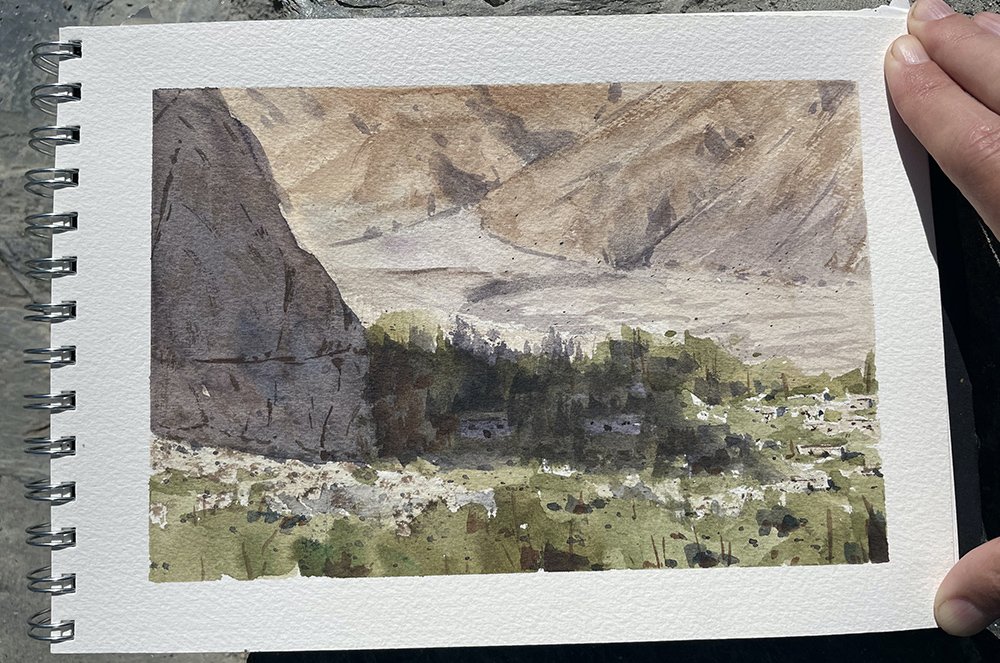Transitioning from Acrylics to Oils
My transition from acrylics to oils was at times frustrating and a bit awkward but in the end it was a natural transition that was necessary for the way I paint and for taking my art to the next level. This isn't to say that you cannot do great things with acrylics, because you can.
I've done some of my best paintings to date in acrylics and I've seen great work done in acrylics. But there are many differences when it comes to painting in acrylics and oils and there are certain limitations to each medium, and given the way that I paint - which is more of an alla prima method [painted all at once, wet on wet] it only makes sense that oils became more appealing to me, rather than painting in many layers with acrylics.
Watercolors - 2010
To be honest, my painting journey originally started with watercolors. I did a few pieces that I liked but overall I wasn't thrilled with watercolors. At the time, I had little painting knowledge and experience since I had only been drawing most of my life. I found watercolors to be challenging and not very forgiving, and also my colors just weren't strong enough for my liking so I decided to give acrylics a try since I had some laying around from a college class I took.
Acrylics - 2011-2015
Acrylics turned out to be quite fun and just came natural to me once I figured out the technical aspects of the paint and the best ways to use it. I used regular acrylics for 3 years before moving towards using Golden's OPEN, Slow-Drying acrylics as my main set of paints. After experiencing their longer drying times, I realized I was unable to execute some of the same techniques I could with normal acrylics.
To solve this problem, I decided to use normal acrylics in conjunction with OPEN Medium. I found this way I could layer as normal and have most of my painting dry quickly while also having specific mixtures and parts of my painting dry slower due to using the medium here and there. This method of saves money too because you don't have to buy all new tubes of paint, you need only buy one bottle of medium which lasts a while.
First Try with Oils - May 2015
I originally put off trying oils for many months as I had no interest at all in longer drying times, exposure to chemicals and what I had thought was the complexity of using oil paints. But, I was becoming quite frustrated with my painting in general so I eventually came to a point where I decided to give oils shot.
My first experiences were a learning process. I didn't quite understand the subtleties of the paint and how to use the thinner or mediums with the paint. And after searching on the internet, I only became more confused about using mediums and how to 'correctly' paint with oils. I came across a few forums where many artists posted which mediums they used or made and most of them disagreed with each other about quality and about how long their paintings would last over the next few centuries and they just seemed to complicate and nitpick the entire process of painting with oils, etc.. and it discouraged me a bit and made me think hard about continuing with using oils - since they seemed more complicated to use compared to what I was used to.
Water-Mixable Oils - May - June 2015
So instead of giving up altogether, I decided to try water-mixable oils. These were much more intuitive for me to use since I was already accustomed to using water with acrylics. The process of painting with these came natural to me. The techniques I used were almost the same as when I painted with acrylics, except for the fact that the paint took longer to dry and I was able to paint wet into wet. I also liked that I didn't need Gamsol or any kind of thinner or other mediums or chemicals.
What I Use Now - July 2015 - Present
After using the water-mixable oils for a few paintings, I moved back to regular oils and something just clicked. I realized that I don't need to use any mediums - I can use the paint straight from the tube. And instead of using water, I simply use some kind of thinner [only in the early stages of a painting] - Gamsol or Eco-Solve. It's been a great experience overall. And my paintings actually dry to the touch within the next day or two after completing, which isn't as big of a deal as I used to think it would be.
The Differences
Lazier Clean Up
Longer Drying Time
More Time for Color-Mixing, Blending, and Corrections [if needed]
Messier
Slightly Stronger Smells
Less Color Shift
Final Thoughts
If you are thinking about transitioning to oils or would like to try them out to see if you like them - I recommend using water-mixable oils since they are quite similar to acrylics in many ways. The only main difference you will notice is the paint will stay wet for longer both on your palette and on your painting. This way, no other materials are needed except for new paints - no thinners or other chemicals needed.

I am an artist, writer, and instructor. As a previous graphic designer for a healthcare management business, I now teach drawing, painting, and discovering your passion with art.
When You’re Ready, Here’s How I Can Help You:

Unlock your artistic potential and learn to draw with confidence using the Intuitive Drawing method. From your first sketch to creating realistic drawings and subjects.














